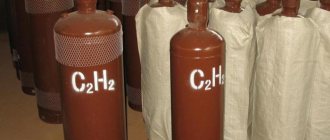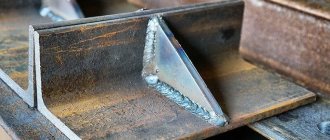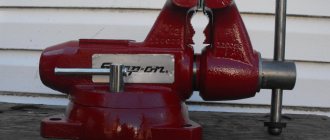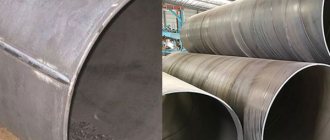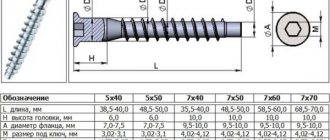Carbide method
You can get acetylene from methane or take calcium carbide as the starting material. The process takes place under normal conditions. When calcium carbide reacts with water, not only acetylene is formed, but also calcium hydroxide (slaked lime). Signs of a chemical process will be the release of gas (hissing), as well as a change in the color of the solution when phenolphthalein is added to a crimson color.
When using technical carbide, which has various impurities, as a starting material, an unpleasant odor is observed during the interaction. It is explained by the presence in the reaction products of such toxic gaseous substances as phosphine and hydrogen sulfide.
Welding process
The use of acetylene during welding must be carried out carefully and in accordance with certain rules. First, the burner should be purged with gas. This must be done until the smell of acetylene appears. After this, the gas is ignited. In this case, oxygen should be added until the flame becomes more stable. From the reducer at the outlet, the pressure of acetylene should be from 2 to 4 atmospheres, and oxygen - from 2 atmospheres.
Welding ferrous metals requires a neutral flame. It has a clearly defined crown and can be conditionally divided into three bright parts: the core is a bright blue color with a greenish tint, the restored flame is a pale blue hue, and the flame torch. The last two zones are working zones.
Before starting work, all parts must be cleaned and then adjusted to each other. When working with a burner, the left and right methods are also used. In the latter case, the seam cools slowly. The filler material typically moves behind the torch. With the left method, the elasticity and strength of the seam increases. In this case, the flame is directed from the welding site. Filler material should be added to the weld pool only after the torch has moved to the next position.
Cracking of petroleum products
Automotive oscilloscope: concept and principles of operation
Currently, it is not only possible to obtain acetylene from methane. The main industrial method for the production of this representative of alkynes is the cracking (splitting) of hydrocarbons. If acetylene is obtained from methane, then energy costs will be minimal. In addition to inexpensive and accessible raw materials, this technology attracts producers of hydrocarbon raw materials due to the simplicity of the technological equipment used in the process of methane dehydrogenation.
Explosion hazard of acetylene and safety when handling it:
Acetylene has explosive properties.
Therefore, handling acetylene requires strict adherence to safety regulations.
Acetylene burns and explodes even in the absence of oxygen and other oxidizing agents.
Mixtures of acetylene with air are explosive over a very wide range of concentrations.
A stream of acetylene released into the open air can ignite from the slightest spark, including from a discharge of static electricity from a finger.
The explosiveness of acetylene depends on many factors: pressure, temperature, purity of acetylene, moisture content in it, the presence of catalysts and other substances, and a number of other reasons.
The auto-ignition temperature of acetylene at normal - atmospheric pressure ranges from 500-600 °C. As the pressure increases, the auto-ignition temperature of acetylene decreases significantly. Thus, at a pressure of 2 kgf/cm2 (0.2 MPa, 1.935682 atm.), the auto-ignition temperature of acetylene is 630 °C. And at a pressure of 22 kgf/cm2 (2.2 MPa, 21.292502 atm.), the auto-ignition temperature of acetylene is 350 °C.
Method for producing acetylene from methane
Methane is one of the most accessible and cheapest types of raw materials for organic synthesis. The substances obtained from it are affordable. The production of acetylene from methane (electrocracking) occurs at a temperature of about 1600 degrees. A stream of methane is passed between the two electrodes, which decomposes into acetylene and hydrogen. The main task is to quickly cool the explosive gas and fill white cylinders with it. In them, acetylene is supplied to construction sites and workshops of industrial enterprises. Here it is used together with oxygen: mixing these gases produces a high-temperature flame used for welding and cutting metals.
Application of acetylene
Acetylene is used in all processes of gas-flame processing of metals (gas welding and gas cutting), due to the high flame temperature, which cannot be achieved when using other combustibles.
For soldering, cutting, surfacing, flame hardening, metallization, gas press welding, welding of non-ferrous metals and alloys, acetylene substitute gases are successfully used:
- propane-butane mixtures
- city gas
- natural gases
- hydrogen
- gasoline vapor
- kerosene vapor
- MAF
- and etc.
In terms of chemical composition, all of them, with the exception of hydrogen, are either compounds or mixtures of various hydrocarbons.
The correct selection and use of substitute gases allows you to achieve high quality welding and cutting, and when gas cutting metals of small thickness, it gives a higher cutting cleanliness.
Gas welding is possible provided that the flame temperature is twice the melting point of the metal being welded. Therefore, substitute gases whose flame temperature is lower than that of acetylene are used for welding metals with a melting point lower than that of steels
For gas cutting, the choice of flammable gas is based on its calorific value, but it must be taken into account that the gas, when burned in a mixture with oxygen, must form a flame with a temperature of at least 2000°C.
The influence of impurities in acetylene on the quality of the weld
Let's look at some more features of the use of acetylene in gas welding - the influence of impurities on the quality of the weld. The following impurities have a harmful effect:
- hydrogen sulfide
- hydrogen phosphide
The above impurities are necessarily removed from acetylene, not only because of the effect on the quality of the weld, but also because of the detrimental effect on the respiratory system and vision of the welder (see the article Explosion hazard, toxicity and self-ignition of acetylene).
Hydrogen sulfide , when burned, forms sulfuric acid, which, when transferred to the weld metal, causes red brittleness. It has been established that the presence of hydrogen sulfide up to 0.007% does not have a harmful effect on the strength of the weld.
Determining the presence of hydrogen sulfide in acetylene is quite easy; you need to hold filter paper soaked in a solution of mercury chloride under a stream of acetylene. In the presence of hydrogen sulfide, the paper will turn white.
The process of purifying hydrogen sulfide is also quite simple - you need to pass acetylene through water, as a result of which hydrogen sulfide will dissolve in water.
Phosphorous hydrogen, when burned, forms phosphoric acid, which, when transferred to the weld metal, causes cold brittleness. It has been established that the presence of hydrogen phosphide up to 0.027% does not have a harmful effect on the strength of the weld.
To determine the presence of hydrogen phosphide, you need to place a piece of filter paper soaked in a ten percent solution of silver nitrate under a stream of acetylene. With a content of hydrogen phosphide of 0.01%, the paper takes on a distinct light yellow color; with a content of more than 0.02%, the paper darkens.
Chemical purification of acetylene from hydrogen phosphide is carried out by passing it through a special cleaning mass - geratol. Geratol is a yellow mass, which, as a result of interaction with hydrogen phosphide, becomes green.
Application of acetylene in the chemical industry
In addition to gas-flame processing, acetylene is used in the chemical industry as the main starting material for the production of a number of important products of organic synthesis: synthetic rubber, plastics, solvents, acetic acid, etc. Next, we will look at how acetylene is used to obtain certain chemical compounds .
Acetaldehyde
The product of the addition of water to acetylene is acetaldehyde. This synthesis was first carried out by M. G. Kucherov in 1881. The reaction proceeds according to the equation:
HC = CH + H2O? CH3 - CHO
The reaction is carried out by passing acetylene through a sulfate solution of mercuric oxide salt at a temperature of 70-80°C.
The use of this reaction was the beginning of the industrial synthesis of organic substances using acetylene as the starting product.
Acetone
When passing a mixture of acetylene and water vapor in a ratio of approximately 1:10 at a temperature of 430-450°C over a zinc-vanadium catalyst, acetone is formed according to the equation:
2C2H2 + 3H2O ? CH3-CO-CH3 + CO2 + H2O
This process has found application on an industrial scale.
Vinyl chloride
When acetylene reacts with hydrogen chloride at 200°C over a catalyst consisting of mercury dichloride supported on activated carbon, vinyl chloride is formed according to the equation:
C2H2 + HCl ? CH2 = CHCl
Vinyl acetate
With acetic acid, also in the presence of mercury salts, acetylene forms vinyl acetate:
C2H3 + CH3COOH ? CH2 = CH-OCO-CH3
Vinyl chloride and vinyl acetate are widely used in the production of plastics.
How much does calcium carbide cost?
Calcium carbide drum 125 kg. 14,000 rub./pack.
Interesting materials:
When can trees be cut? When can you saw down fruit trees? When can you spray trees with copper sulfate? When can you spray trees with iron sulfate? When can you spray trees? When can you spray fruit trees? When can you spray fruit trees with copper sulfate? When can you trim trees? When can you prune trees in the garden? When can you prune trees?
Advantages
The mention of gas welding immediately brings to mind acetylene. Indeed, this gas is most often used for this process. It, in combination with oxygen, provides the highest combustion temperature of the flame. But in recent years, due to the development of various types of welding, the use of this type of metal joining has decreased somewhat. Moreover, in some industries there has been a complete abandonment of the use of these technologies. But for certain types of repair work it still remains indispensable.
The use of acetylene allows you to obtain the following advantages:
- maximum flame temperature;
- there is the possibility of generating acetylene directly at the workplace or purchasing it in special containers;
- Quite low cost compared to other flammable gases.
However, acetylene also has certain disadvantages that limit its use. The most important thing is the danger of explosion. When working with this gas, it is necessary to strictly observe safety precautions. In particular, work should be carried out in a well-ventilated area. If operating conditions are violated, some defects may appear, for example, burnouts.
Storage and transportation
All storage and transportation methods involve the use of cylinders. They are filled with a special mass of porous consistency. It is impregnated with acetone, which dissolves acetylene well. The use of this method can significantly increase the filling capacity of an acetylene cylinder and, importantly, reduces its explosion hazard.
Prolonged contact of acetylene with metals such as copper and silver can lead to an increase in its explosion hazard. Therefore, the use of materials that may contain these metals, for example in valves, is prohibited.
As a rule, cylinders must have special valves designed specifically for acetylene storage.
Full use of the entire container capacity can be achieved by storing empty containers so that the acetone is distributed throughout the entire volume of the container. And this is only possible in a horizontal position. Filling the cylinder must occur very slowly, which is important to comply with the conditions of the chemical reaction of dissolving acetylene in acetone, and in particular its speed.
Chemical properties
Acetylene (ethyne) is characterized by addition reactions:
HC≡CH + Cl2 -> СlСН=СНCl
Acetylene with water, in the presence of mercury salts and other catalysts, forms acetaldehyde (Kucherov reaction). Due to the presence of a triple bond, the molecule is high-energy and has a high specific heat of combustion - 14,000 kcal/m³ (50.4 MJ/Kg). When burned in oxygen, the flame temperature reaches 3150 °C. Acetylene can polymerize into benzene and other organic compounds (polyacetylene, vinyl acetylene). Polymerization into benzene requires graphite and a temperature of 400 °C.
In addition, the hydrogen atoms of acetylene are relatively easily eliminated in the form of protons, that is, it exhibits acidic properties. Thus, acetylene displaces methane from an ethereal solution of methylmagnesium bromide (a solution containing acetylene ion is formed), and forms insoluble explosive precipitates with salts of silver and monovalent copper.
The main chemical reactions of acetylene (addition reactions, summary table 1.):
Read also: Basic crystal lattices of metals
The main chemical reactions of acetylene (addition reactions, dimerization, polymerization, cyclomerization, summary table 2.):
Acetylene decolorizes bromine water and potassium permanganate solution.
Reacts with ammonia solutions of Cu(I) and Ag(I) salts to form poorly soluble, explosive acetylenides - this reaction is used for the qualitative determination of acetylene and its difference from alkenes (which also decolorize bromine water and potassium permanganate solution).
Decarboxylation of carboxylic acid salts (Dumas reaction)
The Dumas reaction is the interaction of salts of carboxylic acids with alkalis during fusion.
R–COONa + NaOH → R–H + Na 2 CO 3
Decarboxylation is the removal (elimination) of a carbon dioxide molecule from a carboxyl group (-COOH) or an organic acid or carboxylate group (-COOMe) of a salt of an organic acid.
When sodium acetate reacts with sodium hydroxide during fusion, methane and sodium carbonate are formed:
Welding technology and modes
Acetylene-oxygen mixtures are used to join parts made of carbon and low-alloy steels. For example, this method is widely used to create permanent pipeline connections. For example, pipes with a diameter of 159 mm with a wall thickness of no more than 8 mm. But there are also some restrictions; joining steel grades 12×2M1, 12×2MFSR using this method is unacceptable.
Selecting mode parameters
To prepare the mixture necessary for combining metals, use the formula 1/1,2. When processing workpieces made of alloy steels, the welder must monitor the state of the flame. In particular, an excess of acetylene should not be allowed.
The consumption of the mixture with the oxygen/acetylene formula is 100-130 dm3/hour per 1 mm of thickness. The flame power is regulated using a burner, which is selected depending on the material used, its characteristics, thickness, etc.
To perform welding with acetylene, welding wire is used. Its grade must correspond to the steel grade of the parts being welded. The diameter of the wire is determined depending on the thickness of the metal being welded.
For the convenience of technologists and welders themselves, there are many tables on the basis of which you can quite easily select a welding mode. To do this you need to know the following parameters:
- wall thickness of welded workpieces;
- type of welding - left, right;
Based on this, you can determine the diameter of the filler wire and select the acetylene consumption. For example, the thickness is 5-6 mm, tip No. 4 will be used to perform the work. That is, based on the tabular data, the wire diameter will be 3.5 mm for left welding, 3.5 mm for right welding. Acetylene consumption in this case will be for left welding method 60-780 dm3/hour, with the right 650-750 dm3/hour.
Welding is performed in small sections of 10-15 mm. The work is performed in the following sequence. At the first stage, the edges are melted. After this, the root suture is applied. Once the root formation is complete, welding can continue. If the thickness of the workpieces is 4 mm, then welding can be performed in one layer. If the thickness exceeds the specified one, then a second one must be applied. It is laid only after the root of the seam has been completed along the entire specified length.
To improve the quality of welding, preheating is allowed. That is, the future welded joint is heated using a torch. If this method is adopted as a basis, then warming up must be done again after each stop.
Seams can be made with gas in any spatial position. For example, when making a vertical seam there are some peculiarities. So, the vertical seam should be made from bottom to top.
When performing welding work, breaks in work are unacceptable, at least until the entire seam is cut. When stopping operation, the burner must be withdrawn slowly, otherwise seam defects - cavities and pores - may occur. An interesting feature exists when welding pipelines; a draft is not allowed in it and therefore the ends of the pipes must be plugged.
